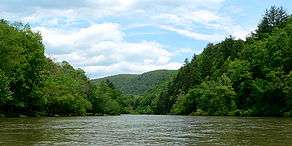Spice Run Wilderness
| Spice Run Wilderness | |
| Part of Monongahela National Forest | |
| Wilderness Area | |
 The Greenbrier River (shown here downstream at Anthony) forms the western boundary of the wilderness. | |
| Country | United States |
|---|---|
| State | West Virginia |
| Counties | Greenbrier, Pocahontas |
| Elevation | 1,965 ft (598.9 m) [1] |
| Coordinates | 38°02′35″N 80°13′59″W / 38.04306°N 80.23306°WCoordinates: 38°02′35″N 80°13′59″W / 38.04306°N 80.23306°W |
| Highest point | Slabcamp Mountain [2] |
| - location | east of Droop Mountain |
| - elevation | 3,284 ft (1,001.0 m) [3] |
| - coordinates | 38°01′39″N 80°12′01″W / 38.02750°N 80.20028°W [3] |
| Lowest point | Greenbrier River |
| - location | south of Spice Run |
| - elevation | 1,949 ft (594.1 m) [4] |
| - coordinates | 38°01′56″N 80°14′19″W / 38.03222°N 80.23861°W |
| Area | 6,030 acres (2,440.3 ha) [5] |
| Established | 2009 [6] |
| Management | Monongahela National Forest |
| Owner | US Forest Service |
| IUCN category | Ib - Wilderness Area |
| Topo map | USGS Denmar |
| Nearest city | Denmar, West Virginia |
|
Location of Spice Run Wilderness in West Virginia | |
| Website: Monongahela National Forest Wilderness Areas | |
Spice Run Wilderness (SRW) is a U.S. Wilderness area within the Monongahela National Forest of West Virginia, USA. Fairly remote, it has no passenger car access whatever.
Access
Users of SRW must enter it via the Greenbrier River (easily fordable at low-normal flows upstream of Spice Run), or by hiking in from the adjacent Calvin Price State Forest, or by driving a high-clearance vehicle to the southeastern corner of the Wilderness along Greenbrier County Route 16.[7]
History
Spice Run was named after a native shrub, Lindera benzoin — known as "spicebush" or "spicewood". The Spice Run Lumber Company created a logging boom town that harvested stands of timber to float down the Greenbrier River for the sawmills. So great were these log runs, that the waterways were choked. The "Run" in Spice Run is from the definition of "Run" as a waterway: "to flow, as a liquid; or, to flow along, esp. strongly, as a stream or the sea: The rapids ran over the rocks."
In 2009, Spice Run was designated a Wilderness along with several other areas of Monongahela National Forest.[6]
Ecology
Aside from Spice Run, the Davy Run and Kincaid Run watersheds are within the Spice Run Wilderness. All three are native brook trout tributaries to the Greenbrier River. Besides fishing, camping, hiking, botany and bird watching are popular activities. There are at least 230 species of birds to watch, and 89 plant species. Nine animals are on the Federal list for endangered species or threatened species such as the northern flying squirrel.
Across the Greenbrier River rests the Greenbrier River Trail, maintained by the West Virginia Division of Natural Resources along the former Chesapeake and Ohio Railway Greenbrier Subdivision. This portion still shows traces of the old lumber-mill on the banks where the flow of logs was controlled. Of the original community of Spice Run, only one house remains standing.
References
- ↑ "Spice Run". Geographic Names Information System. United States Geological Survey. 1980-06-27. Retrieved 2009-09-02.
- ↑ "Spice Run Wilderness Fact Sheet". Wilderness.net. Retrieved 2009-09-02.
- 1 2 Denmar, West Virginia quadrangle (Map). 1:24,000. 7.5-Minute Series (Topographic). U.S. Geological Survey. 1995. ISBN 978-0-607-90810-7.
- ↑ "Davy Run". Geographic Names Information System. United States Geological Survey. 1980-06-27. Retrieved 2009-09-02.
- ↑ "Spice Run Wilderness Map". U.S. Forest Service. 2008-03-11. Archived from the original (PDF) on 2009-09-02. Retrieved 2009-09-02.
- 1 2 "Omnibus Public Lands Management Act of 2009". Library of Congress. Retrieved 2009-05-14.
- ↑ Steelhammer, Rick (2009-10-31). "Spice Run Wilderness: Truly wild, wonderful West Virginia". Charleston Gazette. Archived from the original on 2009-11-01. Retrieved 2009-11-01.
See also
- List of U.S. Wilderness Areas
- Wilderness Act
- Greenbrier River Watershed Association
- Monongahela National Forest